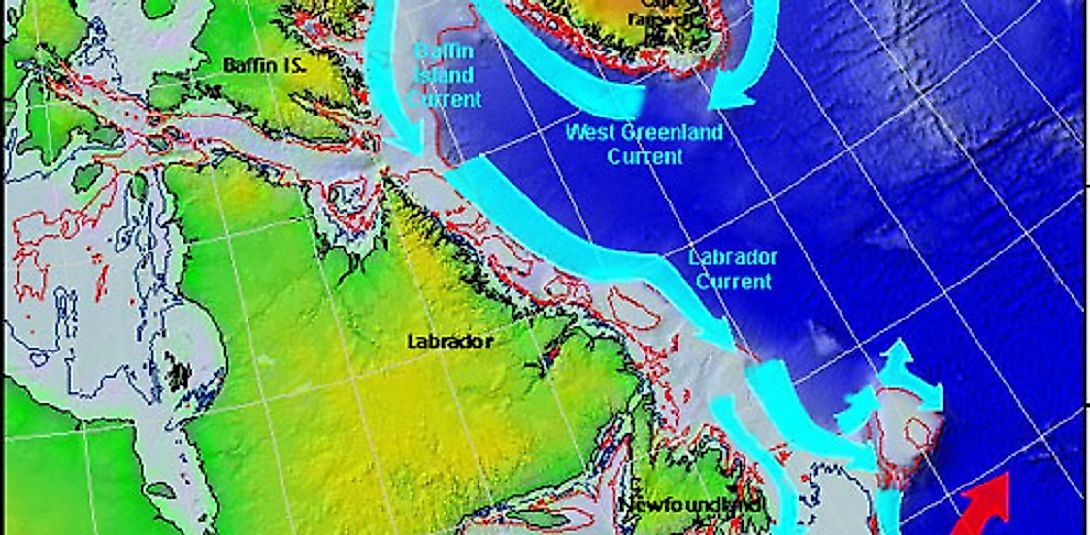What And Where Is The Labrador Current?

5. Description
The Labrador Current is a surface oceanic current in the North Atlantic Ocean that originates at the Davis Strait, where it begins as a continuation of the West Greenland Current and the Baffin Island Current. From there it flows southwards along the western side of the Labrador Sea. The current passes along the coasts of Labrador, Newfoundland, and the east coast of Nova Scotia in Canada. The Labrador Current is a cold current with low salinity, and reaches a maximum depth of around 2,000 feet. It carries a volume of water ranging between 125,000,000 and 190,000,000 cubic feet, and transports numerous icebergs southward.
4. Historical Role
The Labrador Current has always acted as a determinant of the climatic patterns of Canada’s eastern coastal areas. The waters of the current once thrived with commercially important fish species like Atlantic cod, which sustained large scale commercial fishing in the region. The Labrador Current has also been held responsible for a number of major marine disasters of the past. The icebergs and sea-ice sheets carried by the current have often led to numerous shipwrecks, including the sinking of the ill-fated R.M.S. Titanic in the Spring of 1912, in the frigid waters of the Labrador Current off the coast of Newfoundland. Fog created in the region, most notably where the cold waters of the Labrador Current meet the warm waters of the Gulf Stream, has also blinded and sealed the fate of many navigation vessels in the past.
3. Modern Significance
The Labrador Current plays a major role in influencing the climate of the Canadian provinces lying along its path. The relatively lower salinity of the current compared to the waters of the central parts of the Atlantic Ocean makes the water easily susceptible to freezing. The cold waters of the Labrador Current thus have a moderating effect on the climate of the coastal lands in its path, making the summers there cooler, and winters more severely cold. The numerous icebergs in the path of the Labrador Current often act as a barrier to the safe passage of ships. However, the purity of these same icebergs have made them a commercially attractive source of pure water, and also attracts a large number of tourists into the region for iceberg viewing.
2. Habitat and Biodiversity
The water temperatures of the Labrador Current are typically maintained below 32° Fahrenheit (0° Celsius), and its waters have salinities ranging between 30 and 34 parts per 1,000. These fast-flowing cold waters have traditionally supported a diversity of aquatic life, including such fish species as cod, American plaice, capelin, and Greenland halibut, as well as invertebrates like Snow crabs and Northern shrimps. Harp seals and whales are the large predatory aquatic mammals of the Labrador Current ecosystems. However, overfishing over the last several decades has greatly reduced the fish species of the region, and conversely promoted a population explosion among the invertebrates. Fisheries in the region thus generate profits from the large scale shrimp and Snow crab catches from the waters of the Labrador Current at levels never seen before.
1. Environmental Threats and Territorial Disputes
The climate of eastern Canada and northern Europe are dependent on the Labrador Current and the Gulf Stream Current, respectively. As climate change threatens to reduce the force and flow of the Labrador Current, the flow of the Gulf Stream Current will be diverted towards the northwest Atlantic, diminishing the effects of this current in northern Europe. This will be responsible for colder climates in the region, as the warming influence of the Gulf Stream Current will be absent. The weakening Labrador Current will, however, result in milder winters in Canada’s eastern provinces. Furthermore, the ongoing melting of Arctic ice due to global warming will load more waters into the Labrador current, slowing down its speed, thereby impacting the migration of seals and white beluga whales, and contribute to the threatening rise of sea levels globally..











